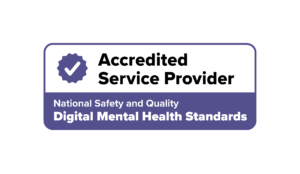ADHD in women
Women with ADHD may be more likely to receive a diagnosis later in life. Women’s experiences with ADHD can also differ from what people expect when they think about ADHD.
If you’re a woman with ADHD, it may have taken longer or may have been more challenging for you to receive an ADHD diagnosis. There are multiple possible reasons for this. Firstly, it could be at least partly due to society’s different expectations regarding the behaviour of boys and girls. These different expectations may mean that the same symptoms (e.g., excessive talking and interrupting) could be interpreted differently depending on whether the person is a male or a female. For example, in a recent position statement on ADHD across the lifespan, the Royal Australian and New Zealand College of Psychiatrists (RANZCP) noted that stereotypes about gender – such as the stereotype of “the ‘chatty girl’” – currently contribute to the under-recognition of ADHD in females.
Another thing that may contribute to a delayed or missed diagnosis is that girls and women with ADHD tend to be more likely to present with more inattentive symptoms, and fewer hyperactive and impulsive symptoms, compared to boys and men with ADHD. (Inattentive symptoms can include being easily distracted or disorganised, which can lead to feeling overwhelmed.) Since inattentive symptoms are less disruptive in education, work, and family environments, they are easier to miss.
The RANZCP also notes that it is common for females with ADHD to mask and internalise their symptoms, and this can also lead to missed diagnosis and/or misdiagnosis.
Additionally, the symptoms of ADHD can overlap with or can co-occur with multiple mental health problems, some of which are more common in women, and this can make it more difficult for clinicians to diagnose ADHD. For example, in both ADHD and post-traumatic stress disorder (PTSD), people tend to have difficulty concentrating, restlessness or irritability, and impulsivity. Furthermore, individuals with ADHD are more likely to have a history of trauma. This is one of the reasons why it is important that your therapist is skilled and experienced in diagnosing ADHD as well as considering differential diagnoses.
In addition to the challenges associated with delayed diagnosis and misdiagnosis, girls and women can face challenges with experiencing ADHD in ways that are different to what they or society may expect.
• For example, it may be harder for people in their life to understand or accept their ADHD diagnosis, since they may not have as many hyperactive or impulsive symptoms that would otherwise make the diagnosis easier for people to see. This might change in the future, though, as awareness increases of the different ways that ADHD can present.
• Some people with delayed diagnosis also go through a period of distress, grief, or anger with the health system in light of how delayed their diagnosis was.
Client story: Jessie
Jessie* is a 20-year-old woman from rural NSW who was studying an agricultural studies course at TAFE when one of her tutors suggested that she should look into whether she might have ADHD. Jessie had been struggling to keep up with her class work for a while, and was considering dropping out. But at the suggestion of her tutor, she visited her GP, and got a referral to Call to Mind.
Jessie had never really had difficulties with hyperactivity symptoms and was surprised that her tutor and then her GP had raised the possibility of ADHD. She explained to them: “I just thought I sucked at school.” She had always had difficulty paying attention, even when the topics interested her. She was easily distracted and would get lost in her own thoughts.
Jessie’s GP referred her to a Call to Mind psychiatrist, who conducted a thorough psychiatric assessment and also contacted her family to confirm the pattern across her life. A Call to Mind psychologist helped to assess how much Jessie’s functioning was being affected by the symptoms she was experiencing. They also helped to rule out various different cognitive problems as possible explanations for the symptoms.
After these assessments, Jessie was diagnosed with ADHD, with an inattentive presentation (because most of her symptoms were inattentive symptoms). She initially engaged in some ADHD coaching.
After discussing her options with her psychiatrist, Jessie decided to trial (try out) a stimulant medication. The first medication she tried did not improve her symptoms much, and she found it suppressed her appetite and made her feel anxious. So, her psychiatrist offered her an alternative.
Over the next 2-3 months of the second medication she tried, Jessie noticed a sustained improvement in her ability to focus, to the point where she “stopped noticing it was an issue.” After years of assuming that she would just always struggle with academia and coursework, she found that she could achieve a lot more than she would have imagined.
Jessie has now finished her course and she plans to work for a few years prior to further study.
*Not her real name.
Resources Box
A recent meta-analysis found that boys and girls with ADHD tend to present differently, meaning that they tend to present with different collections of symptoms. The main findings were that:
● Girls with ADHD tend to be less hyperactive than boys with ADHD. Girls with ADHD tend to have fewer difficulties with inhibiting their behaviours and being cognitively flexible.
● On the other hand, girls and boys with ADHD did have differences in the degree to which they faced problems with executive functioning.
There are several podcast episodes and YouTube videos featuring women talking about their experiences with ADHD. We have listed some examples below. Please note that these are not Call to Mind resources and they are not hosted by health professionals. We do not control the content and have only listened to some of the episodes. If you have specific questions about topics, please ask your psychiatrist or therapist.
● How to ADHD is a popular general education channel for anyone with ADHD (or for anyone who is curious to learn about it)
● Here’s an episode where she talks about women’s experiences with ADHD
● ADHDAF stands for ADHD As Females, but the hosts of this podcast series introduce their episodes by saying that they intend the podcast to be welcoming to people of any gender.
● Is it My ADHD? is a podcast series hosted by Grace Timothy, who explores the experiences of women and non-binary people living with ADHD.
● Women & ADHD is a podcast and YouTube series hosted by Katy Weber, who received her diagnosis at 45 years of age and was then inspired to explore the experiences of other women who have received ADHD diagnoses in their adulthood. Here’s a recent example of an interview with an Australian:
● An interview with an entrepreneur from Melbourne named Marie Ng, who was diagnosed with ADHD after a colleague noticed her symptoms in her early 30s.


